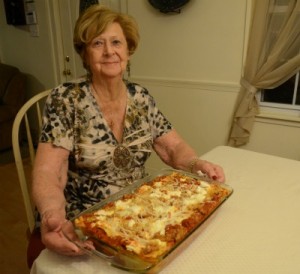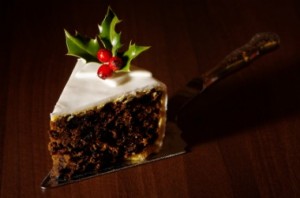
Mamma mia: Jean Catherine McNulty Meade
When I was a kid growing up in Norwich, N.Y., and later Willow Grove, I can remember vividly the days when my mother made her tomato sauce. It seemed like an all-day project, the sound of sauce burbling away in the big aluminum stockpot, and the intoxicating Mediterranean ambrosia of olive oil and garlic filling the house.
No jarred Ragu for my mother; instead, the patient preparation of a thick, deep red, richly flavored topping for spaghetti or filling for lasagna, made all the more scrumptious by a generous dusting of Locatelli Romano cheese, grated fresh at the table, with thick, golden buttery slabs of garlic bread on the side.
Not at all bad for a woman born Jean Catherine McNulty.
How she came to cook Italian food so well is, in its way, a mystery. My grandmother died when my mother was very young, so she, her sister Mary Alice and brother Richie learned at an early age how to keep house, in a series of flats throughout Jersey City. Mary Alice in particular was the cook.
“Mary Al was good at whatever she made,” my mother recalls. “She was a great cook. She didn’t like to clean up afterwards … I was the cleaning person.”
How it came to be that Mary Alice was such a great Italian cook isn’t clear. The story I’d always heard—or thought I’d heard—was that Mary Alice learned to cook from her husband Tony Lionetti’s mother. Not true, says my mother … but the real story is lost in the mists of time. Whatever the story, Mary Alice’s in-laws were impressed.
“She was a better Italian cook than her in-laws,” my mother says. “They loved her cooking.”
The reason my mother became proficient in the ways of pasta is a lot clearer.
“When I got married, I couldn’t boil water,” she says. “The only thing I knew how to make was pancakes. I had my in-laws over for dinner, and we had pancakes. How dumb can you get?”
With Mary Alice’s help, my mother smartened up. “I was on the phone every day with Mary Alice, every time I had to cook something.”
The result, all these years later, is truly mouth-watering Italian food. (I hasten to add that, when I was growing up in Norwich, there were two Catholic churches: The snooty Irish church, St. Paul’s, up on the hill overlooking town, and the Italian church, St. Bartholomew’s, in the center of town, across from a deli. So some of my pseudo-Italian heritage comes from years of great food at festivals and spaghetti dinners, lovingly overseen by our black biretta-wearing pastor, Father Guido Festa.)
If you ask me: Why Italian food? Why Now? I can’t tell you. Maybe you should blame it on St. Patrick’s Day overload. And the truth is, if given a choice between ham and cabbage, and a simple garlicky dish of aglio y olio, I’ll go for the pasta every time.
So the first thing I thought of to share was my mother’s sauce and lasagna recipes. But then I reached out to our Facebook fans, looking for more recipes that were the offshoot, in some way, shape or form, of the marriage of tricolors.
Try them out and see if you don’t break out in a rousing chorus of “La Donna è Mobile.”
Jean McNulty Meade’s Sauce
Ingredients
4 diced or crushed garlic cloves
A little olive oil, enough to coat the bottom of a stock pot and a large frying pan (always Pompeian, in its distinctive grooved bottle, in our house)
2 6-ounce cans of tomato paste
2 tomato paste cans of water
28-ounce can of tomato puree or crushed tomatoes
15-ounce can of tomato sauce
1 teaspoon of parsley flakes
1 full teaspoon of crushed sweet Basil
½ teaspoon of sugar
½ to ¾ pound of sweet Italian sausage
¾ pound of groubd beef (93 percent fat-free)
Directions
Coat a stock pot with olive oil. Saute garlic cloves. Discard them when soft.
Add two cans of tomato paste and water. Stir.
Add tomato puree and sauce, sugar (it cuts the acidity a little), parsley and basil.
Coat a frying pan with olive oil.
Remove sausage from casing, and chop up in the pan. Add the ground beef and do the same. When cooked through, add to sauce.
Allow the sauce to simmer at least two hours. The longer, the better.
This is the same recipe my mother uses for both spaghetti and meatballs, and lasagna.
Jean’s Lasagna
Ingredients
1 16-ounce box of lasagna noodles
8 ounces of ricotta
Grated Locatelli (You’ll have to eyeball it. My mother swears by Sam’s on Moreland Road in Willow Grove)
3 cups shredded mozzarella
Sauce
Directions
Preheat oven to 350 degrees.
Cook noodles according to the package directions. When done, place them in a strainer and run a little cold water over them.
In an oiled 13×9 pan, ladle in a little sauce, then place a layer of noodles (usually 4 across) over the sauce.
Next, place a third of the ricotta, mozzarella (space it out) and a little sauce on top of the noodles.
Layer noodles, cheeses and sauce two more times. Place the final layer of noodles on top, and then cover with sauce and Locatelli.
Cover the dish with foil (it helps to spray with cooking spray). Bake 45 minutes. Remove foil and bake another 10-15 minutes.
You’ll have a hard time sinking a fork into it right away, but let it sit for 10 minutes or so before serving.
And there’s more …
Kathy DeAngelo’s Lentil Soup
Kathy is the harp-and-fiddle half of Irish traditional music duo McDermott’s Handy. When she was growing up, lentil soup was Friday night dinner, especially during Lent. “It’s a pretty cheap meal, too, and full of nutrition,” she says, “which was very practical for our large family.”
Ingredients
1 bag of lentils
1 pkg frozen cut spinach
1 medium sized onion
Tomatoes (either 1 can tomato paste, 1 can diced tomatoes, or 1 can of tomato juice, whatever’s handy)
Parsley, Oregano, Garlic
Salt to taste
Directions
(In Kathy’s own words.)
Soak the beans if you can, overnight or for a couple of hours. It’ll take the sugar out of them and they’ll cook faster too.
Drain the lentils. Then put them in a big pot and add new water, enough to cover the lentils about 1.5 inches. Start cooking over a rather high heat.
Put in the frozen spinach (take it out of the package first!). Chop up the onion and throw that in.
You need some kind of tomatoes–look in the pantry and find whatever canned tomatoes are handy and throw that in.
How much parsley & oregano? I pour in enough to layer each on the top of the lentils, more or less. If you don’t like oregano, don’t put any in.
Garlic? For that big pot, you can start with 2 tablespoons, reserving the right to add more later if that’s what you like. Stir it all up and after the spinach breaks up, leave it alone.
When it all starts to boil, turn down the heat and cook it on medium heat. If the water steams away and it’s too thick, add more water but don’t overdo it. This should be a rather thick soup.
Serve hot and sprinkle lots of parmesan/romano on the top and a crusty slice of Italian bread with butter.
Optional adds: You can add pasta to this if you don’t mind the added calories. Little tubetini macaroni work best. Cook them separately al dente and add them to the lentils. If you’re not a vegetarian, get some Italian sweet sausage, slice it up in bite size chunks and brown it separately in a pan. Throw that into the boiling lentils mixture. You can also use tuna in this lentil soup and it’s pretty good too.
Monica Woolston-Versaggi’s “Toralli” Lemon Cookies
Monica is one of our Facebook friends, and she presented us with this sweet recipe, from her husband’s grandmother.
Ingredients
6 eggs
1 cup sugar
¾ cup oil
2 teaspoons lemon extract
5 cups sifted flour
4 teaspoons baking powder
Directions
(In Monica’s own words.)
Beat eggs; add sugar beat ‘til creamy. Add oil and lemon extract.
Add flour and baking powder which have been sifted together.
Let dough rest for 10 minutes. (It will be sticky; if I have time, I do refrigerate it overnight.)
Shape into a crescent shape ( about 1 ½ tablespoons).
Bake at 375 degrees for 10 minutes.
Icing
Ingredients
1 egg white
½ teaspoon lemon extract
1 ½ cups of confectioner’s sugar
1 teaspoon milk
Directions
Mix until a thick consistency. It should not be too thin. Spread on cool cookies.
Enjoy with a cup of tea!!
Maria Gallagher’s Eggplant Parmesan
Maria’s one of our Ladies Ancient Order of Hibernians pals. Both of her parents are second generation Italian.
“My dad’s family is from a town in Sicily called Messina, and my mom’s family is from up north near the Seashore Coastline. I am full-blooded Italian, but was able to join the LAOH because I am the spouse of an Irish member and I have a daughter who is a member of the Ladies. That is how our by-laws read.”
The recipe, Maria says, is her own, with some help from her mom.
Ingredients
2 medium-size eggplants
2 eggs
Bread Crumbs
Flour
Gravy (Known as “sauce” in some Italian households, but definitely “gravy” in Maria’s. Her gravy is homemade; you can use the jarred stuff, if you want.)
4 cups mozzarella cheese
Grated Parmesan or Romano cheese
Extra virgin olive oil
Directions
Preheat your oven tp 350 degrees.
Peel eggplant and slice into quarter-inch pieces. Salt and then pat dry.
Coat the eggplant slices in flour; shake off the excess. Dip in egg, then in bread crumbs.
Heat olive oil in pan and cook eggplant slices until brown on both sides.
Cover the bottom of a casserole dish with gravy. Add a layer of eggplant, mozzarella cheese and Parmesan or Romano cheese. Repeat with another layer until all eggplant is covered.
Bake for about 35-40 minutes.



